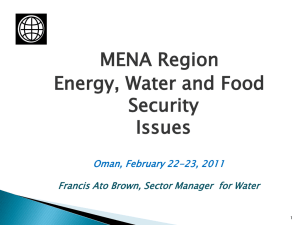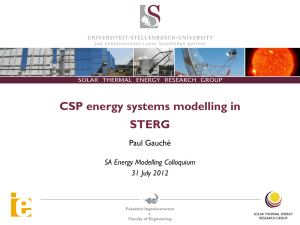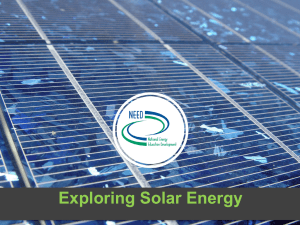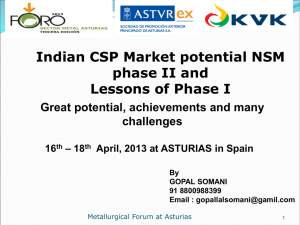6 Professor Robert PITZ-PAAL
advertisement
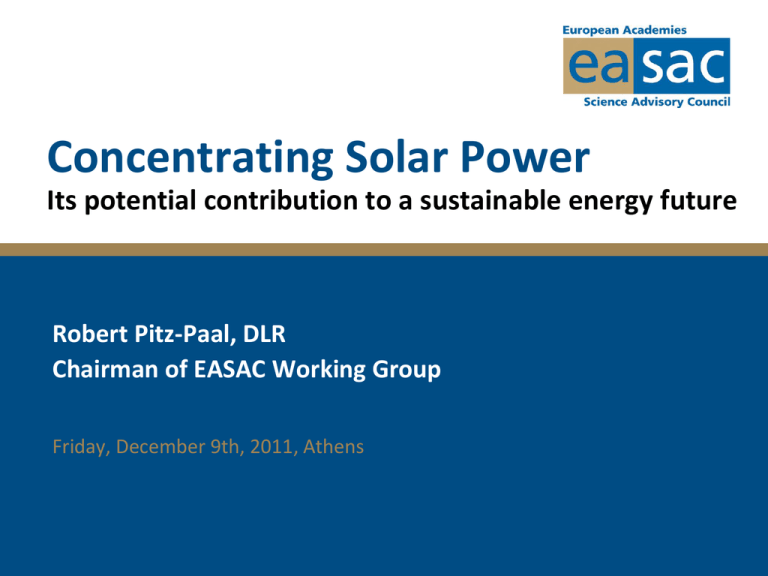
Concentrating Solar Power Its potential contribution to a sustainable energy future Robert Pitz-Paal, DLR Chairman of EASAC Working Group Friday, December 9th, 2011, Athens Working Group Membership • • • • • • • • • • • • • • Professor Amr Amin, Helwan University, Egypt Professor Marc Bettzüge, Cologne University, Germany Professor Philip Eames, Loughborough University, UK Dr. Gilles Flamant, CNRS, France Dr Fabrizio Fabrizi, ENEA, Italy Professor Avi Kribus, Tel Aviv University, Israel Professor Harry van der Laan, Universities of Leiden and Utrecht, Netherlands Professor Cayetano Lopez Martinez, CIEMAT, Spain Professor Fransisco Garcia Novo, University of Seville, Spain Professor Panos Papagiannakopoulos, University of Crete, Greece Mr Erik Pihl, Chalmers University of Technology, Sweden Professor Robert Pitz-Paal (Chair), DLR, Germany Mr Paul Smith, University College Dublin, Ireland Professor Hermann-Josef Wagner, Ruhr-Universitat Bochum, Germany 2 Key Questions • • • • • What is Concentrating Solar Power (CSP)? The Value of CSP Electricity Today’s Markets and Costs Cost Reduction Potential Potential Role of CSP Technology in Europe and Middle East and North Africa (MENA) • Challenges • Recommendations • Potential Benefits for Europe 3 What is CSP ? Conventional power plants 4 What is CSP ? Solar thermal power plants 5 What is CSP? 6 The Value of CSP Electricity >95 % +2000 h 2000 h • • Flexible Design: From peak load to base load at similar costs Thermal Storage = high efficient shift of supply 7 The Value of CSP Electricity Components of value: – kWh’s of electrical energy – Contribution to meeting peak capacity needs – ‘Services’ to support grid operation Conclusions: – Must evaluate at system level – Value of storage increases as more variable renewables on system – All 3 components of value can be significant – Subsidy schemes need to reflect the price signals from competitive electricity markets – Auxiliary firing as transition technology 8 Today‘s Markets: Parabolic Troughs are most mature technology 9 Today‘s markets: New concepts (Tower/Fresnel) target for faster cost reduction 10 Today’s Markets 11 Today’s levelized cost of electricity Technology LEC €c / kWh CSP: 100 MW w/o storage (Arizona) 17.9 Pulverized coal: 650 MW: base-load 6.9 Pulverized coal: 650 MW: mid-load 9.0 Gas combined cycle mid-load 6.1 Wind onshore: 100MW 8.5 Wind offshore: 400 MW 15.3 Photovoltaic: 150 MW (Arizona): 21.2 Calculation based on Data form US Department of Energy 2010, (Currency conversion 2010 $/€ = 0.755) 12 Competition with PV and Wind • LEC for onshore wind is less than half of CSP costs today • LEC for large scale PV has dropped below CSP in 2011 • PV and wind are not dispatchable – cheep electric storage is not available today • The value of dispatchability depends on the system and is mostly not reflected in the revenue schemes • Integration of larges shares of variable renewable (like wind and PV) will increase the value of dispatchability • CSP may therefore complement / enable larger shares of Wind and PV in a low carbon energy system 13 How to reduce costs? Estimates based on detailed engineering studies • Mass production and scaling (25 - 30%) • Technology improvements (20 - 30 % ) Breakthroughs in – Front Surface Reflectors (Lifetime) – Heat Transfer Fluids for higher temperature (Stability and costs) – Advanced Solar Power Cycles (Solarized Design) – Storage Systems (Adaptation to Temperature and Heat Transfer Fluid) LEC < 9 €cents/kWh realistic based on technology concepts already realized in lab-scale today Rate of cost reduction depends on learning rate and growth rates. The authors estimate cost breakeven with fossil fuel between 2021 and 2031 9€cents/kWh for CO2-free dispatchable grid power is anticipated to be competitive in some markets in 2025 14 Role of CSP in Europe and MENA Region CSP Potential: Europe 1‘800 TWh (1/2 EU consumption) MENA > 600‘000 TWh in brackets: (max. yield in GWhel / km² /y) 17 Role of CSP in the MENA Region Favourable factors: – – – – Size and quality of solar resource Rapidly increasing indigenous demand Proximity to Europe and its appetite for CO2-free power High level of local supply share of CSP technology (up to 60% by value by 2020) Issues: – Investment conditions and ownership arrangements – Subsidy schemes and continuity of initiatives – Export v home use 18 Challenges • parity with fossil fuel energy in the next 10 to 15 years • grid infrastructure and market mechanisms to integrate large fraction of CSP in southern Europe and MENA (potentially for export) • appropriate political and economic boundary conditions in MENA to support long term investments in low-carbon technologies 19 Recommendations (1/2) • Incentive schemes – Reflect the true value of electricity to the grid – Ensure transparency of cost data – Progressively reduce over time / market volume • R&D – Ensure new technologies progress rapidly from laboratory, via demonstration to commercial – Cover fundamental research, breakthroughs and storage systems in an integrated approach that allows for the required scale-up and demonstration steps – Develop market incentivation models that favours cost reduction by innovation over cost reduction by mass production of state of the art technology options 20 Recommendations (2/2) • Renewable Energy Mix – Perform system simulation studies to evaluate the long term potential of renewables technologies in different markets and the value of dispatchability – Support technology development based on their longer term potential • Transformation process – Identify technical, political and socio-economic factors necessary to achieve integration of EU and MENA energy systems – Direct significant Co-funding/financing (€ Billions) by EU as part of neighbourhood policy to RES / CSP project in the MENA region – Support capacity building • Transmission capacity – Strengthen Grid in EU and in MENA – Establish HVDC EU-MENA links 21 Benefits for Europe • CSP has potential to become a zero-carbon, low-cost dispatchble electricity supplier for southern Europe (and MENA) • CSP can potentially reduce the amount of (still expensive and inefficient) electric storage systems (pumped hydro, CAES, Power2Gas) needed in the system • CSP has a high local supply share creating local value and jobs • Co-operation with MENA could accelerate global climate protection and stimulate sustainable economic development as part of the neighboring policy • Transnational HVDC Interconnections (EU-MENEA) are likely to reduce the overall transformation costs of the Energy System 22
